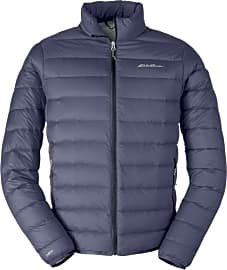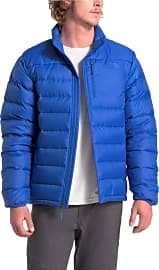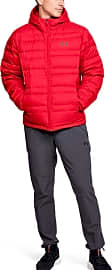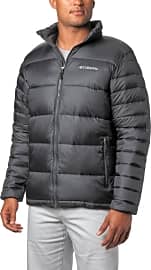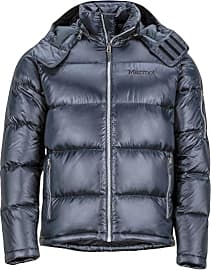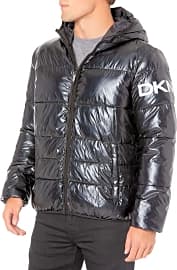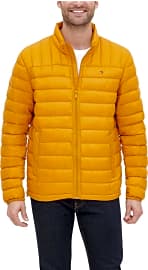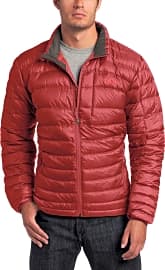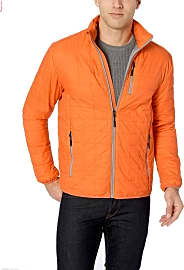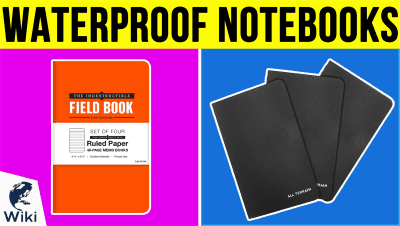The 10 Best Men's Down Jackets

This wiki has been updated 42 times since it was first published in September of 2016. Our best advice for when the temperature outside drops into an uncomfortable range is to stay indoors and enjoy a nice hot beverage. But if you absolutely have to venture outdoors, make sure you stay toasty warm in one of these insulated men's down jackets and coats. Coming in a variety of quilted styles to suit any taste, they are available at prices to meet any budget. When users buy our independently chosen editorial selections, we may earn commissions to help fund the Wiki.
Editor's Notes
October 17, 2020:
Styles come and go, but the classic puffer jacket will likely remain a staple in many men's closets for years to come. This popularity combined with the utility they are known for means manufacturers are constantly engineering better jackets to withstand the elements and keep you comfortable. When updating this list, we wanted to ensure all our choices were on-trend without sacrificing that practicality.
You'll find options for seriously cold temperature drops, like the Arc'teryx Cerium LT and Marmot Stockholm, while pieces like the Cutter & Buck Rainier and Tommy Hilfiger Packable are ideal for milder (but still frigid) winters and nippy fall seasons. These latter two offer simplistic silhouettes and forego some of the more hardcore details brands like Columbia, The North Face, and Arc'teryx integrate and you'll see that trade-off in a lower price point. The Eddie Bauer CirrusLite, however, manages to incorporate a plethora of thoughtful features while still keeping the cost in the affordable range for most people.
Joining the ranks today is the stylish DKNY Logo, which hearkens back to the old jackets that were popular with rappers and other celebrities in the 90s. It manages to conjure that nostalgia without going over the top and features a high-loft fill and wide quilted sections that not only enlarge the silhouette but also make it feel as though you're wearing a cozy, lightweight blanket.
We also brought on the Under Armour Hooded, which was designed for athletes and anyone who is prioritizing movement after warmth. It uses all-over 600-fill power allied duck down that's ethically sourced and traceable via the hangtag, joining the likes of The North Face Aconcagua and Eddie Bauer model for compassionate sourcing. The Aconcagua also sports deep pockets perfect for stashing your phone, a waterproof notebook, or snacks without anyone noticing.
November 02, 2019:
Down jackets are a favorite garment when temperatures drop for a number of reasons. First, they're stuffed with feathers which insulate and hold heat without adding unnecessary weight or bulk — something campers, hikers, and the like will definitely appreciate. Second, they generally take up little space. You can fold them up and stuff them in your backpack easily and still have room for your other supplies, and some even come with pouches for simple storage and transport. With a down jacket or coat, you can keep warm and maintain a full range of motion, too, which can't always be said for garments made from thicker materials such as wool.
The Eddie Bauer CirrusLite, The North Face Aconcagua, Calvin Klein Coat, and Cutter & Buck Rainier have been added to the list. The CirrusLite was chosen due to its simple yet classic design, and The North Face Aconcagua for its durability and appealing color options. The other two newbies were picked because of their popularity among outdoor enthusiasts. By contrast, the Patagonia Sweater Jacket, Mountain Hardwear Ghost Whisperer, Rab Neutrino Endurance, and 32 Degrees were removed due to various issues including availability and quality concerns.
Special Honors
Black Yak Thebe Notably expensive, but meticulously crafted for high activity, this option from Black Yak uses a variety of materials strategically arranged to breathe and stretch in the right places. It uses a combination of down and synthetic fill for reliable mapped insulation, and sports a plethora of pockets of varying sizes and a fitted stretch fleece hood for added protection. blackyak.com
Cotopaxi Fuego Fans of the classic ski chalet style will appreciate this selection's seventies-inspired stripes. It comes in three appealing color combinations, hooded or un-hooded versions, and is stuffed with 800-fill-power goose down that is responsibly sourced, water-resistant, and packs plenty of insulation power. cotopaxi.com
Stio Hometown A luxury selection ideal for everyday wear, the Stio Hometown is filled with responsibly-sourced and water-repellent 800-fill goose down and sports a recycled nylon ripstop outer to shield you from the elements and keep you dry. It has a soft, buttery feel, high loft, mid-size baffles to keep the down in place, a fixed peripheral adjust hood, a zippered handwarmer and chest pockets, interior stash pockets, adjustable hem, and much more. stio.com
Down With the Thickness
Fill power is usually expressed as cubic inches per ounce, which is measured when the down is fully expanded.
While a great men’s down jacket will turn heads, it’s likely that you want one not just to look good, but to be warm, too. So, when shopping for a down jacket, one of the most important measurements you’ll want to pay attention to is the fill power, which measures the loft of the down and its attendant insulating abilities. Fill power is usually expressed as cubic inches per ounce, which is measured when the down is fully expanded. For example, a down fill rating of 700 means that when an ounce of down is at its fluffiest, it covers 700 cubic inches.
Why is this important? Because down with a higher fill power has more air pockets, which means it will insulate better and keep you warmer. Most men’s down jackets fall somewhere between 500 and 800 fill power, which impacts the price of the garment. The other measurement that impacts price and quality is the fill weight, which tells you how much down is in the jacket. A high fill weight leads to a jacket that’s warmer but heavier and denser, while a fill weight on the lower side gives you one that may not keep you as warm but will compress extremely well for packing.
There are a few other things to think about when selecting a down jacket, as well. If you’re vegan, there are synthetic down jackets available that are just as warm as those made from goose or duck down. This type of down is usually made from ultra-fine polyester fibers that can imitate bird down’s lofty clusters, although you’ll usually need more of it to achieve the same warmth. For this reason, synthetic down jackets are sometimes a bit less compressible.
And don’t forget to look at the outer materials and how well the jacket will stand up to wet conditions. Real down doesn’t dry particularly quickly, so a jacket with a water-resistant shell is a good idea. Or, if you live in a truly wet, cold climate, synthetic down might be the better choice, as it dries much faster. Finally, if you plan to be doing any strenuous activities, look for a shell made from durable nylon that can stand up to abrasions.
Caring For A Down Jacket
Listen up, guys. A down jacket is not the kind of garment you can leave wadded up in the back of your closet during the months when it’s not in use. Not if you expect it to keep you feeling warm and looking hot, that is. After all, a quality winter jacket is an investment, and we want to help you protect it. Luckily, it’s not that hard to properly care for a down jacket. (For those modern men who understand the importance of proper clothing care, we apologize, but read on, because we want to keep your garment game on point.)
To help the jacket fluff back up, put a couple of tennis balls in with it — these will help distribute the filling evenly.
Although some down jackets, such as those with silk content, must be dry cleaned, the majority can go right into your washing machine. Choose a gentle cycle and cold water, and go ahead and spot treat any stains with diluted detergent before you throw it in. After it’s clean, you can put it in the dryer, again selecting a low temperature. To help the jacket fluff back up, put a couple of tennis balls in with it — these will help distribute the filling evenly. You might take the jacket out halfway through the cycle and smooth out the filling, too, which will help prevent clumping.
Unless you are doing a lot of sweaty, strenuous activities, you should really only need to wash a down jacket once or twice per season. In the warmer months, hang it on a quality coat hanger. Be sure not to leave it packed away in its stuff sack. Leaving a down jacket compressed for long periods can wrinkle the outer fabric and lengthen the down’s re-loft time.
If you see any feathers poking out, resist the temptation to pull them through the fabric. Instead, gently push them back in so that you don’t risk creating a hole. If you do end up with a hole or tear, you can use fabric patching tape or even duct tape. This type of repair job lends a certain rugged air to the garment, but if that’s not your thing, a qualified tailor might be able to sew the fabric together.
A Brief History Of The Down Jacket
The men’s down jacket was born out of the kind of necessity that usually comes after a near-death experience. Way back in the 1930s, legendary sportsman and designer Eddie Bauer was out on a fishing trip that almost turned tragic. Finished for the day, he and a friend were hiking their way out of the canyon they’d been angling in, when Bauer stopped to rest. He was wet and half frozen, and he reports that a sleepiness began to creep over him — the beginnings of hypothermia. His friend was already some way ahead of him, but Bauer was carrying a revolver, which he fired into the air to alert his companion of his predicament. Alone, Bauer most likely would not have survived, but his friend was able to provide him the help he needed.
Back at the design board, Bauer reflected on stories his uncle had told him about his time in the Russian Army and about the feather jackets they wore to stay warm in the sharp, cruel cold. The prototype Bauer produced used goose down that was held in place with diamond quilting. Working with a friend who was a climber, he perfected the design and ultimately started offering the jacket, dubbed the Skyliner, for sale in 1936. The garment was a smash success and a staple product in the Eddie Bauer line up until the 1980s.
Bauer may have patented the original, but today, a whole host of companies and designers produce down jackets for men in a variety of styles and colors. These jackets may go by different names, including puffer or “puffa” coats, but they all have one thing in common — they can trace their modern lineage back to the Skyliner and the resilience of man against the weather.


